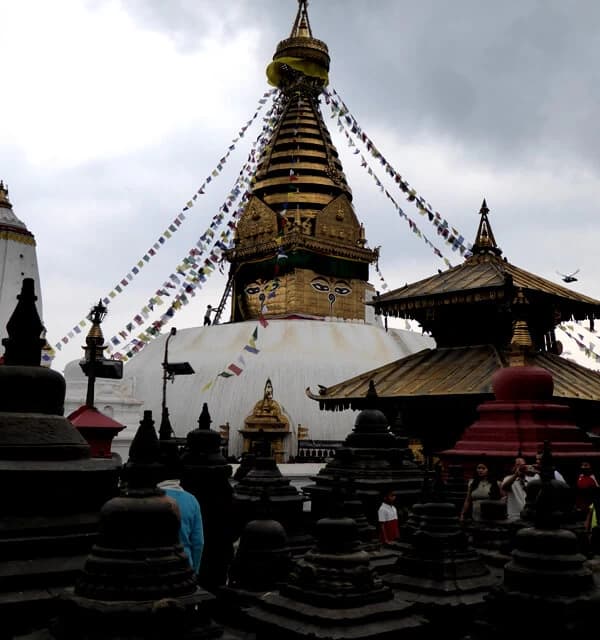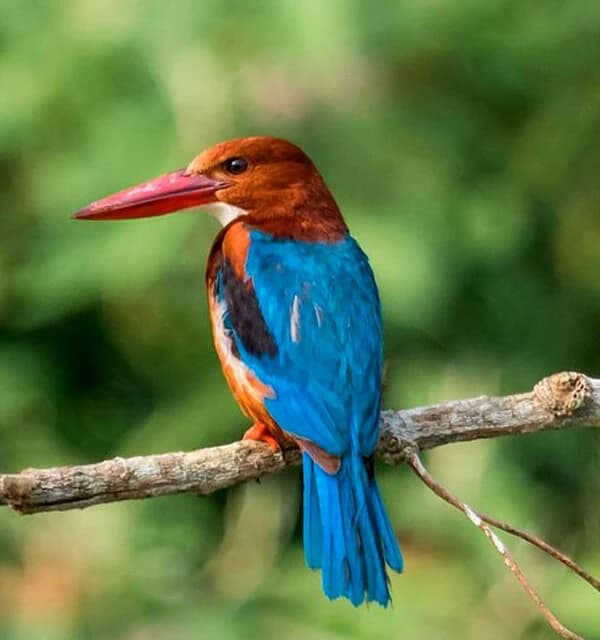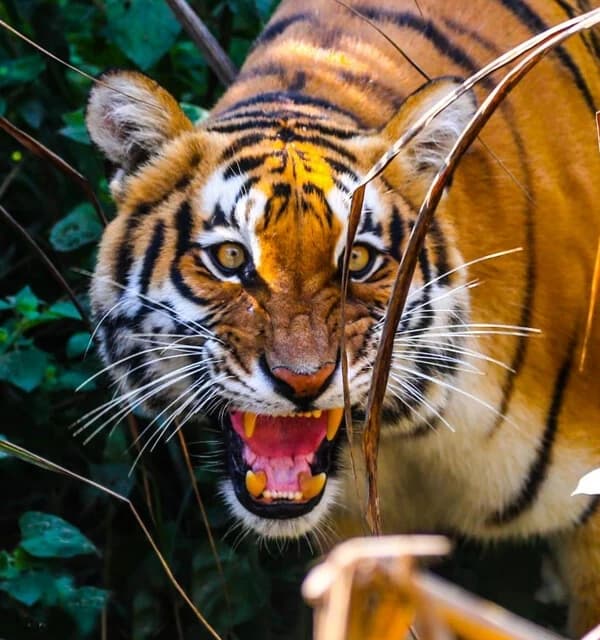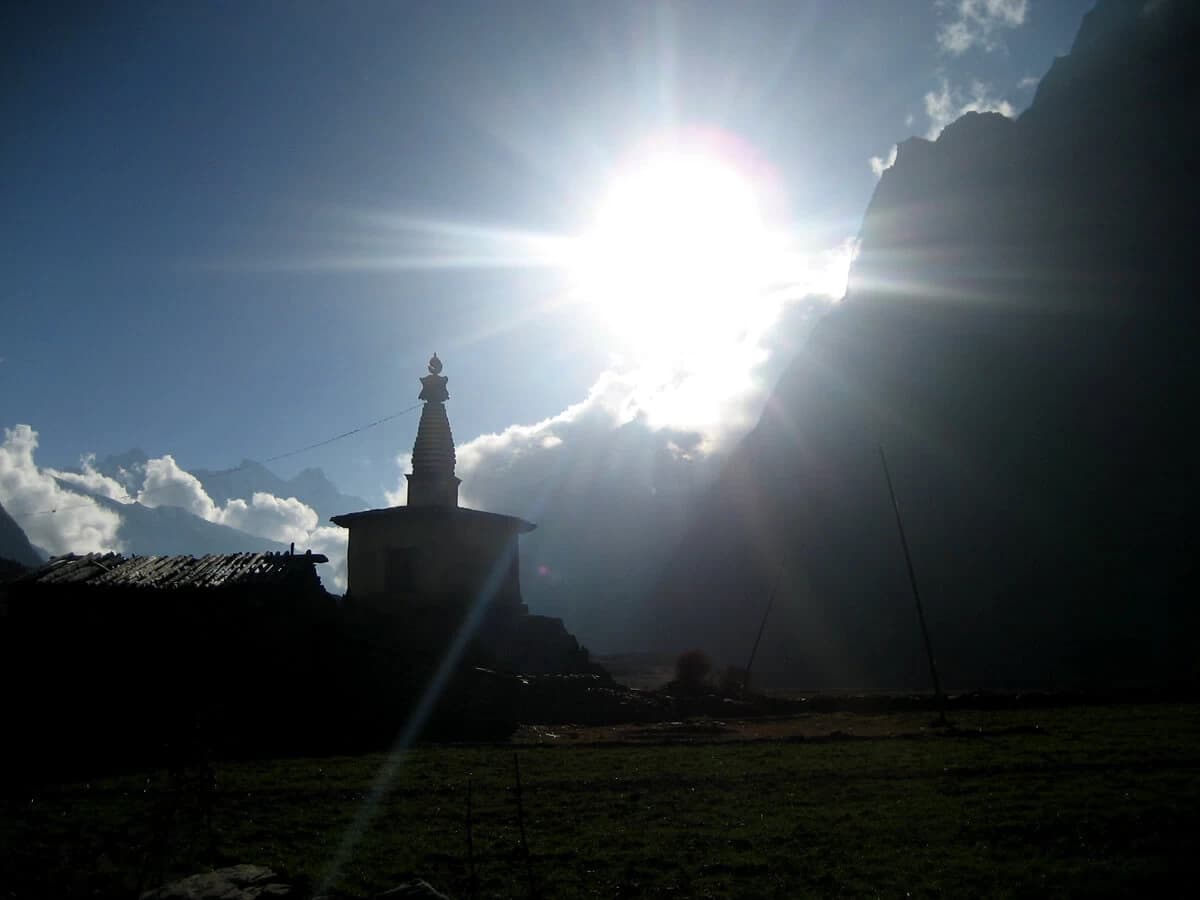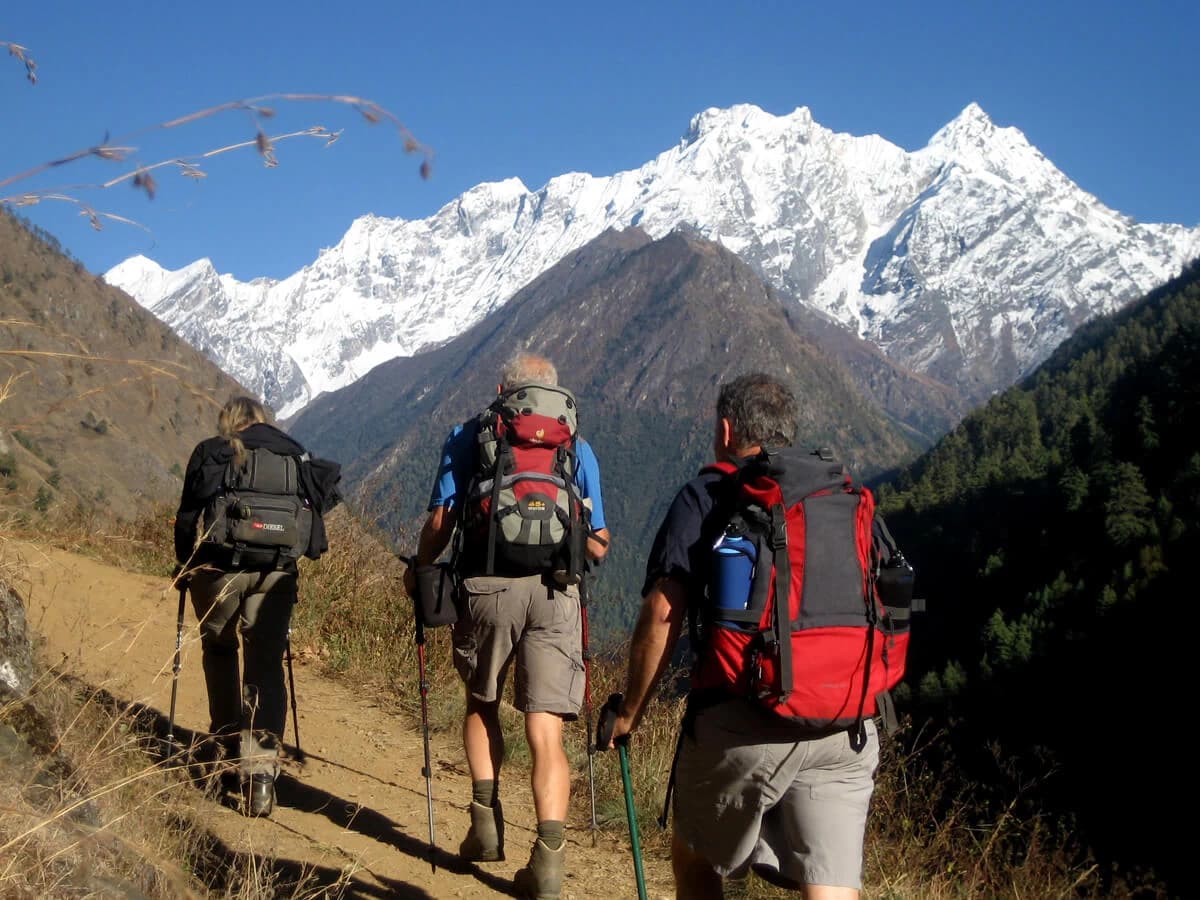Trek Manaslu and Tsum Valley, crossing Larke Pass (5160 m), for a remote adventure. Experience Tibetan culture, stunning peaks, and homestays in Nepal's hidden Shangri-La.
Manaslu and Tsum Valley Trek - 17 Days
Manaslu and Tsum Valley Trek Overview
Manaslu and Tsum Valley Trek through the dramatically adventurous Larke Pass (5160 m) is one of the most thrilling and appealing trekking journeys in the isolated and remote Shangri-La of Northern Gorkha in Nepal. This area is known as the land of monasteries, charming hamlets with rough, steep tracks, and less comfortable accommodations in Tsum Valley. The area is renowned for its homestay experience, getting engaged with locals, and magnificent mountain scenery, but it is less visited. It is located in the northern part of Manaslu at the Nepal-Tibet border and is remarkably popular among adventure trekking holiday fans. In 1991, the Manaslu region was opened for foreign visitors, and Tsum Valley was opened for trekkers in 2008. The area is geographically extra fabulous and culturally most attractive. The natives and locals of upper Budi Gandaki, a region known as ‘Nup Ri,’ meaning western mountain, are direct descendants of Tibetan immigrants; they inhabited it here during the early 16th century, so their language, dress, and traditions are completely similar to Tibetan. The mountain view in Nup Ri is astonishing and dramatic. Larke Pass is an exhilarating experience.
Why should you consider the Manaslu Trek with a side trip to Tsum Valley?
Tsum Valley is yet to be explored and discovered; it is exactly the place to trek for the rural traveler passionate about discovering a more unusual part of the world than yours. The valley is blessed with a Himalayan Buddhist pilgrimage site located in the northern part of the Gorkha district, Nepal. The word ‘Tsum’ refers vividly to the majestic background setting of the beautiful Ganesh Himal, Sringi Himal, and Boudha Himal ranges, and this tranquil Himalayan valley is enriched with ancient art, culture, and the Himalayan Buddhist religion. It is said that the Buddhist saint Milarepa is believed to have meditated in the caves of these mountains. The valley is home to some unique and historic monasteries, mani, kaanis, and prayer walls, which lie on a pretty highland nestled in the lap of the valley, and Gompa Lungdang, located at the base of a conical hill against the main slope of Ganesh Himal. The tribes here celebrate numerous Buddhist festivals, perform ritual burning of juniper incense to purify the air, and place prayer flags for the happiness of all the sentient living beings installed in Mani Walls. The remote area has been left behind, so their culture remains as it was hundreds of years ago. The trek is appealing for wilderness lovers away from their comfort zone.
What are the logistics of the Manaslu Trek via Tsum Valley?
Manaslu and Tsum Valley Trek can be accomplished as a lodge trek, also known as a teahouse trek, now that Tsum has several lodges, fine homestay services, and toilets available in most places. There are now phone call services throughout, and rare mobile reception in case of an emergency. The isolated Tsum Valley side trip should not be missed if you are doing Manaslu. The area draws attention to its complete well features of the trek, with strong, friendly, welcoming locals, a living Buddhist culture, and untouched wildlife because of Buddhist prohibitions on hunting and killing. The people are poor since they have been bypassed by development for centuries, but this means their unique culture has remained ideal and intact. However, a road from China is already pegged out and will cause rapid change. Tsum is said to be a Beyul, one of the hidden valleys that 8th-century Buddhist saint and master Padmasambhava blessed as refuges to be discovered when the planet is approaching destruction and the world becomes too corrupt for spiritual practice. They are valleys reminiscent of glory and paradise, which can only be reached with enormous hardship.
Main Feature of Manaslu Circuit Trekking with Tsum Valley:
- 16 nights and 17 days guided Manaslu and Tsum Valley Trek.
- Get out of the luxury zone and experience a public bus ride from Kathmandu to Soti Khola
- Learn about isolated Tibetans, like the local people, and their lifestyle
- Mount Manaslu, the world’s eighth-tallest mountain, and its glacier
- Discover Tibetan Buddhist monasteries and religious monuments.
- Venture through the dramatic Larke Pass over 5106m
- Walking through tropical green hills, alpine, and tundra zones
Cost of Manaslu and Tsum Valley Trekking Permit for the year 2025/26
These controlled area permits for Manaslu and Tsum can be obtained from the Department of Immigration in Kathmandu. Both Manaslu and Tsum require separate permits. Joining a registered trekking agency is obligatory to get permits, and it is mandatory that you be accompanied by a licensed guide. A party of two or more foreigners should be in a group, although these requirements may be relaxed in the future. The Manaslu Trek Permit Costs are USD 100 for the first week (then USD 15 per day) for September, October, and November, and USD 75 for the first week (then USD 10 per day) from December onward till August. For Tsum, the same periods apply, but the fee is USD 40 for the first week. You will need a TIMS card (Trekkers Information Management System) as well if you are continuing on the Annapurna Circuit through Thorong La Pass, so you’ll need 4 photos for all this. In our experience, if you are only circuiting Manaslu, your special permit means that a TIMS card is not required.
You will need two additional permits: MCAP (Manaslu Conservation Area) NPR 3000 each and ACAP (Annapurna Conservation Area) NPR 3000 each for the section from Dharapani to Besi Sahar after you join the round-Annapurna trail.
How are accommodations and meals on the Manaslu Trek with the Tsum Valley Side Trekking Route?
As there are now lodges and teahouses, you do not need to bring food and camping gear from Kathmandu; you could stay in teahouses and eat there. Wilderness Excursion arranges a local, experienced guide for your Manaslu and Tsum Valley for the entire route to ensure that immediate benefits flow to this remote area and to get an insight into the culture.
How long is the itinerary and the distance of the Manaslu trek with a side trip to Tsum Valley?
We have crafted an 17-day itinerary; however, you can ask us to customize the trip, and even you may like to add more of some other excellently recommended side trips, such as the Manaslu and Tsum Valley routes, to explore more going out of the main track that provides you with a peaceful retreat environment without others distracting your mind.
Our proposed Manaslu Circuit Trek with a side trip to Tsum Valley trekking itinerary is 17 Days. It can be customized or slightly changed according to your requirements, considering your shape, pace, and trekking habits, which may cause a change to the day-to-day plan.
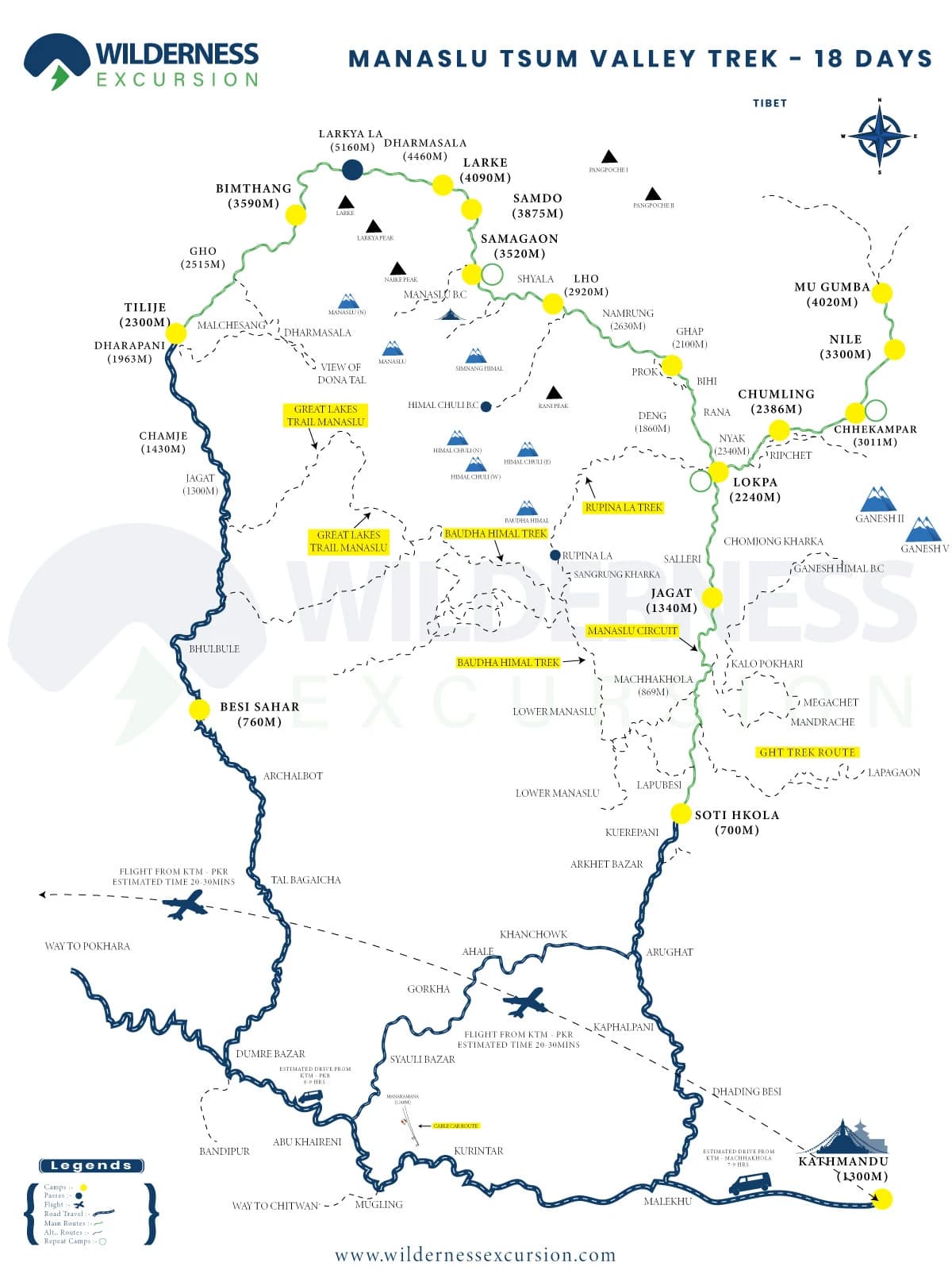
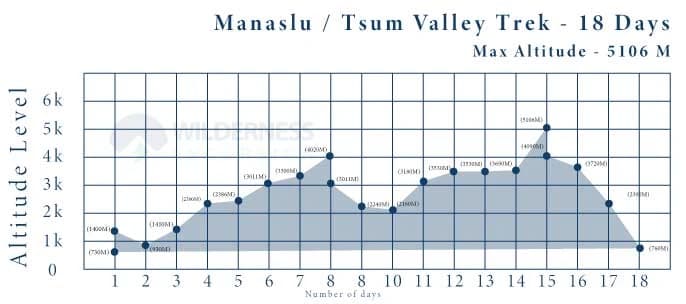
- Manaslu and Tsum Valley local trek with a private guide for 17 days, as per the itinerary.
- An assistant guide if the group size exceeds 6 people
- One shared porter between 2 trekkers to carry your main pack (weight limit: 25 kg)
- Meals: 17 breakfasts, 18 lunches, and 17 dinners during the trek.
- Lodge and homestay accommodation on a double-sharing basis.
- Guides and porters wage with all their expenses for the trek.
- All necessary Manaslu and Tsum Valley trekking permits.
- Public bus transportation to the starting point
- Public shared jeep from trekking to Besi Shahar & Kathmandu
- All taxes and documentation fees.
- Bar bills and beverages such as Coke, mineral water, beer, etc.
- Transfers, meals, and accommodation in Kathmandu.
- Guided tour in Kathmandu (can be arranged upon request at extra cost).
- Laundry service, toiletries, and personal nature expenses.
- Hot shower and hot water, internet, and phone calls
- Personal travel insurance and trekking gear.
- Rescue operation charge in case of emergency.
- Tipping your guide and porter.
At Wilderness Excursion, 13 years of excellence in operation with decades-long expertise in leading treks in Nepal. To further enhance your Manaslu Tsum Valley Trek, we’re pleased to introduce exclusive add-ons for an even more exceptional adventure.
Private Jeep Service USD 415: Upgrade Your Transport for a More Comfortable Journey; it will cost extra USD 415 for a round trip shared by the participants.
Benefits of upgrading to a private Jeep:
✓ Direct route: No multiple stops like the public bus
✓ Faster travel time - Reach the trailhead sooner
✓ More space: Comfortable seating for you and your gear
✓ Flexible departure: Choose your preferred start time
✓ Scenic comfort: Enjoy the views in private comfort
Check our dates published to see if it matches your time. We are happy to customize your tour perfectly to match your interests and needs, creating a unique travel experience just for you
Typically you will need 18 to 21 days to complete Manaslu Circuit Trek with side trek to tsum Valley for a week. And there are hidden side trip worth to visit. The length of trek will be according to your pace and side trip you include on it.
The Manaslu and Tsum Valley Trek is located in the northern part of the Gorkha district in Gandaki Province within the Manaslu Conservation Area, and it is west of Kathmandu, the capital city of Nepal.
Manaslu and Tsum Valley Trek is rated as a moderately difficult trek requiring good physical fitness due to long hiking days on steep, rugged, and rocky terrain, with many ascents and descents. Altitude is a significant challenge, going over 500-meter elevations, and the remote nature of the region means basic amenities, making good preparation and a guide essential for a safe and rewarding experience.
In the Manaslu and Tsum Valley treks, charging cameras and mobile phones is possible at most lodges and teahouses, but it typically involves paying around NPR 100 to 200 per device for a full charge. The power is often from solar or small generators, which can be unreliable. Therefore, Wilderness Excursion suggests that you fully charge your gadgets where electricity is available and carry a power bank and/or a portable solar charger as backup.
Usually, almost all the accommodations in Kathmandu and Pokhara keep your excess luggage for free storage; if not, Wilderness Excursion will keep your stuff and get it after the trek completion. Check with your accommodation if you can deposit the baggage with hotel you stay.
You can get bottled water on the first two days and the last days of the trek, but where bottled water is banned to stop the environmental pollution, you can get safe drinking water, or you can use the purifier (use a tablet or device) to drink spring water.
No, you can not use the Credit or Debit Card in the Manaslu and Tsum Valley Trek; you are advised to get enough cash exchanged or withdraw while in Kathmandu.
